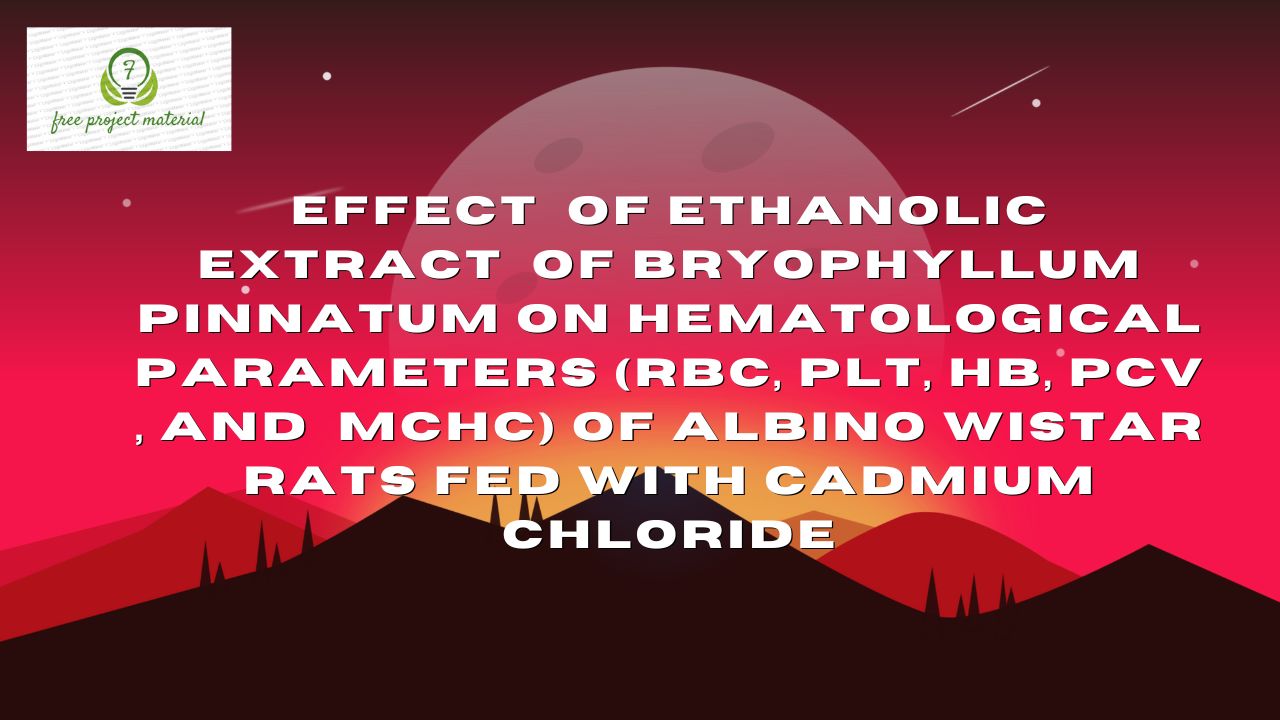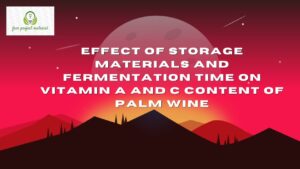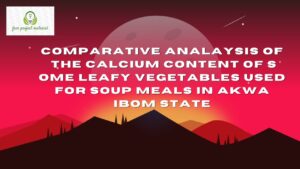ABSTRACT
This research was undertaken to investigate the effect of ethanolic extract of Bryophyllum Pinnatum leaves on some haematological parameter of male albino wistar rats fed with cadmium chloride. The haematological parameter analyzed were RBC, HB,PLT, MCHC and PCV.20 albino wistar rats that weight 80-160g were randomly assigned to 5 group of 4 rat each.Group 1 ( positive control) received water and rat mash. Group 2 ( negative control) was fed with water, rat mash body weight of cadmium chloride.Group 3,4 and 5 received water, feed, 26.4mg/kg body weight cadmium chloride weight of the ethanolic plant extract respectively.The result of the haematological parameter (RBC,HB,PLT,MCHC and PCV) showed a non significant (P<0.05)decrease in all the groups. Therefore the plant extract has the potency of treating menorrhagia, hemorhoids and hematemesis. Thus the plant should be utilized in the treatment of cadmium toxicity.
TABLE OF CONTENTS
Title page – – – – – – – – i
Certification – – – – – – – – – ii
Dedication – – – – – – – – – iii
Acknowledgement – – – – – – – – iv
Abstract – – – – – – – – v
Table of contents – – – – – – – – vi-viii
List of plates – – – – – – ix
List of table – – – – – – – – –
INTRODUCTION
1.1 Background of the study – – – – – – 1-3
1.2 Aim and objective of the study – – – – – 4
1.2.1 Aim of the Study – – – – – – – 4
1.2.2 Objectives of the Study – – – – – – 4
1.3 Scope and limitation of the study – – – – – 5
1.4 Significance of the study – – – – – – 5
1.5 Definition of terms – – – – – – – 6
1.6 Abbreviation – – – – – – – – 7
CHAPTER TWO
Literature review – – – – – – – –
2.1 Scientific classification of Bryophyllum pinnatum – – – 8
2.2 Description of Bryophyllum pinnatum – – 9-13
2.2.1 Distribution and pharmacological relevance
of Bryophyllum pinnatum – – – – 14
2.3 Phytochemial constituents of
Bryophyllum pinnatum. – – – – 15-16
2.4 Use of Bryophyllum pinnatum – – – – 17
2.5 Heavy metals – – – – – – 17-18
2.5.1 Essentials metals – – – – – – 19-20
2.5.2 Toxicity of metals to the biological system – – 21
2.5.3 Absorption and distribution
of cadmium in the body – – – – 22-23
2.5.4 Cadmium Absorption from the
Gastrointestinal Tract and lungs – – – 24
2.5.5 Transport of Cadmium in the Blood – – – 24
2.5.6 Localization of Cadmium in Tissue – – – 25-26
2.5.7 Mechanism of cadmium toxicity – – – 27-28
2.5.8 Clinical Implication of Cadmium Toxicity – – 29
2.6 Treatment of cadmium toxicity – – – 29
2.7 Haematological parameters – – – – 30
2.7.1 Hemoglobin – – – – – – 30
2.7.2 Red Blood Cell – – – – – – 31
2.7.3 Packed Cell Volume – – – – – 32
2.7.4 Mean Cell Hemoglobin Concentration – – 33
2.7.5 Blood platelets – – – – – – 34-35
CHAPTER THREE
Materials and methods
3.1 Materials and reagents – – – – – 36-37
3.2 Methods – – – – – – – 38
3.2.1 Sample collection and preparation – – – 38-39
3.2.2 Preparation of plant Sample – – – – 39
3.2.3 Preparation of Heavy Metal – – – – 40
3.2.4 Experimental Design, Grouping And
Treatment Of Animal – – – – – 40
3.2.5 Collection of Blood Sample And
Preservation Of Serum – – – – – 41
3.2.6 Determination of haematological parameters – 42
3.3 Statistical analysis – – – – – – 43
CHAPTER FOUR
4.0 Result and discussion – – – – – 44
4.0 Physical and morphological changes – – – 44
4.1 Result – – – – – – – 45-47
4.2 Discussion – – – – – – – 48-51
CHAPTER FIVE
5.0 CONCLUSION AND RECOMMENDATION
5.1 Conclusion – – – – – – – – 52
5.2 Recommendation – – – – – – – 52
References
CHAPTER ONE
INTRODUCTION
1.1 Background of the Study
Medicinal plant contains substances that can be used for therapeutic purpose or which are precursors for the synthesis of useful drugs.
Plants are naturally gifted at the synthesis of medicinal compound, whose characterization has led to discovering of new cheap drugs with high therapeutic potential.
The world health organization(WHO) estimated that 80% of the world population depend on medicinal plants for their primary health care (Gupta et al., 2010).
Medicinal herbs have a hopeful future, since there are about half a million plants around the world, most of them have not yet been studied in medicinal practice and current and future studied on medical activities can be effective in treating disease. Herbal medicine are in great demand in the developing countries for primary health care because of their wide biological and medicinal activities. These medicinal plants are consider as a rich resource of ingredients which can be used in drug development and synthesis. Besides that these plants play a critical role in the development of human culture around the whole world.
More ever, some plants has this important source of nutrition and as result of that these plants are recommended for their therapeutic values.
These plants include ginger, green tea, walnuts and some other plants which include Mangifera indica, Mimosa pudica, Lepidium sativum, Euphorbia thymifolia, Archyrantes aspera, Carica paraya, Phyllanthus poltphyllus Bryophyllum pinnatm e.t.c.
Mangifera indica is a species of mango in the Anacardiaceae family. It is found in the wild in India and cultivated varieties have been introduce to other warm region of the world.
These Mangifera indica are used for diuretic activity. Euphorbia thymifolia is a small branched pubscent, prostate annual herbs commonly known as stimulant astringent (Kane et al;2019).
Extracts from roots of Achyranthes aspera have been reported to possess spermicidal activity in human and rat sperm (Paul et al., 2010). Carica papaya fruits to family of caricaceae. Papaya fruits contain a mixture of cysteine endopeptidase which posses a wound healing properties. Phyllanthus polyphllus is a small shrub used in anti-inflammatory folk medicine in tropical and sub tropical region.
Bryophyllum pinnatum is also known as Kalanchoc pinnatum. It has a sour taste, hot strength and sugary post digestive effect.
The herb contain a wide range of valuable chemical that could be responsible for various pharmacological effects
The plant parts are frequently applied for the cure of burns, rheumatoid, arthritis, antiseptic, blister, cough, suppression, insect bites, psychiatric disorder and abdominal discomfort. It is well known for its anti-inflammatory, wound healing analgesic and hemostatic qualities.
Arroud the globe Bryophyllum pinnatum is also use for the treatment and management of various pathologies such as edema, conjunctivitis, piles, edema, constipation , epilepsy, cholera, asthma chest colds menstrual disorders, chicken pox, and fever(Kirtika , 1975).
1.2 Aim and Objective of the Study
1.2.1 Aim of the Study
The basic aim of this research project is to determine the effect of ethanolic extract of Bryophyllum pinnatu on haematological parameter of albino Wister rats feed wit cadmium chloride
1.2.2 OBJECTIVE OF THE STUDY
The objectives of this study is
- To determine the effect of cadmium chloride on the haematological parameter in normal albino Wister rats.
- To determine the effect of ethanolic extract of Bryophyllum pinnatum on the haematological parameter in albino wistar rats administered with cadmium chloride.
- To compare the result of this analysis with the normal range of the individual hematological parameter and the work of other researchers.
- To make recommendation and suggestion for further studies based on the result obtained from this study.
1.3 Scope and Limitation of the Study
The scope of the study covers the effect ethanolic extract of Bryophyllum pinnatum on the haematological parameter of male albino rats feed with cadmium chloride.
However the limitation of the study include the time frame given to this research and the poor financial support obtain in carrying out the research work.
1.4 Significance of The Study
The result obtain from this research work will be useful to medical doctors, pharmacist, herbalist etc. In verifying the believe obtain from folk lore medicine in the effect of Bryophyllum pinnatum on cadmium (heavy-metal) poisoning.
The result will also be useful to other researchers in giving directive and providing pinnatum on the hematology levels of male albino rats exposed to heavy metals.
The result obtain will recommend or stop the use of Bryophyllum pinnatum chelating agents.
1.5 Definition of Some Terms
Medicinal plants; these are plants when contain compounds that either posses therapeutic purposes or serves as precursors for the synthesis of useful drugs (Sofawora, 2008). They sre crops which exerts beneficial pharmacological effect on human or animal bodies to treat or prevent specific ailments or disease in veterinary practice.
Phytochemicals; these are naturally occurring non-nutritive chemicals (secondary metabolites) that are responsible for the protective health effect of plant-based food beyond the vitamins or mineral benefits of the plant. This include chemicals such as alkaloids bufadienolides sterods saponins etc.
1.6 Abbreviation
MCHC – Mean cell haemoglobin concentration
RBC – Red blood cell
PCV – Pack cell volume
PLT – Platelet
WHO – World health organization
CD – cadmium
CNS – central nervous system
SEM – Standard error of mean
PPM – Part per million


